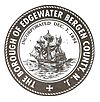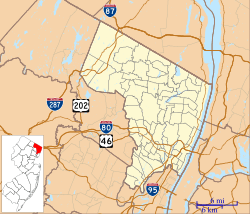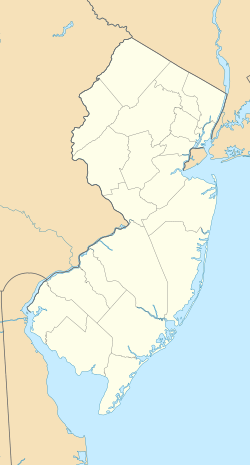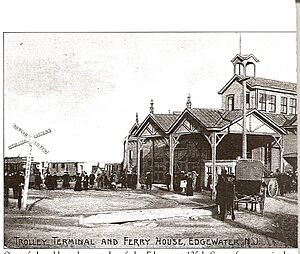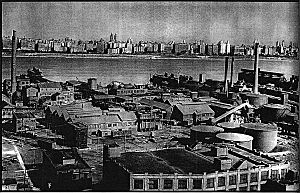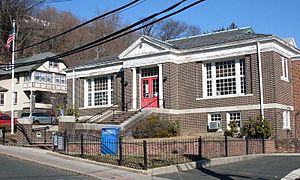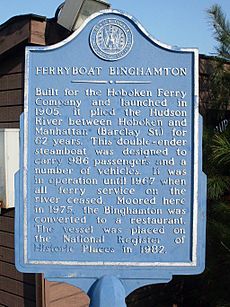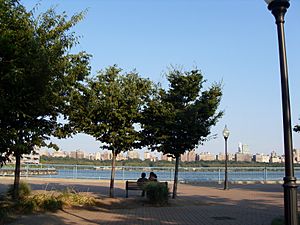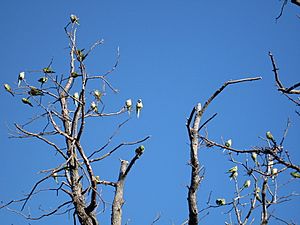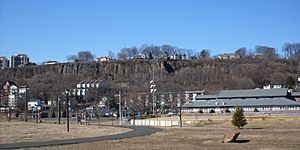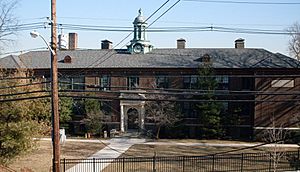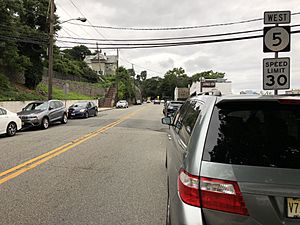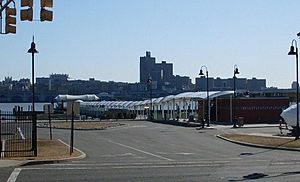Edgewater, New Jersey facts for kids
Quick facts for kids
Edgewater, New Jersey
|
||
|---|---|---|
|
Borough
|
||
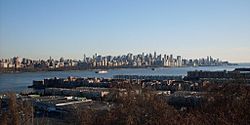
Edgewater, New Jersey, in the foreground, overlooking Manhattan across the Hudson River in the background
|
||
|
||
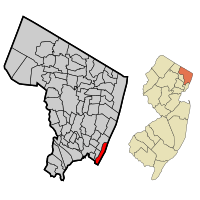
Location of Edgewater in Bergen County highlighted in red (left). Inset map: Location of Bergen County in New Jersey highlighted in orange (right).
|
||
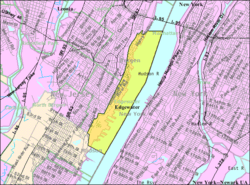
Census Bureau map of Edgewater, New Jersey
|
||
| Country | ||
| State | ||
| County | Bergen | |
| Incorporated | December 7, 1894, as Undercliff | |
| Renamed | November 8, 1899, as Edgewater | |
| Government | ||
| • Type | Borough | |
| • Body | Borough Council | |
| Area | ||
| • Total | 2.43 sq mi (6.29 km2) | |
| • Land | 0.97 sq mi (2.52 km2) | |
| • Water | 1.46 sq mi (3.78 km2) 60.33% | |
| Area rank | 376th of 565 in state 39th of 70 in county |
|
| Elevation | 3 ft (0.9 m) | |
| Population
(2020)
|
||
| • Total | 14,336 | |
| • Estimate
(2023)
|
14,678 | |
| • Rank | 184th of 565 in state 24th of 70 in county |
|
| • Density | 14,764.2/sq mi (5,700.5/km2) | |
| • Density rank | 19th of 565 in state 6th of 70 in county |
|
| Time zone | UTC−05:00 (Eastern (EST)) | |
| • Summer (DST) | UTC−04:00 (Eastern (EDT)) | |
| ZIP Code |
07020
|
|
| Area code(s) | 201 | |
| FIPS code | 3400320020 | |
| GNIS feature ID | 0885203 | |
Edgewater is a borough in Bergen County, New Jersey. It is located right along the Hudson River. In 2020, about 14,336 people lived there. This was a big jump from 2010, when the population was 11,513.
Edgewater has a rich history. It was home to the first colony in Bergen County. It also played a part in the Revolutionary War. In the 1800s, it was a quiet town with resort hotels. Then, in the early 1900s, it became an industrial area with many factories. Later in the 20th century, it changed into a fast-growing place where many people live.
Edgewater became an official town on December 7, 1894. It was first called the Borough of Undercliff. This happened during a time when many new towns were being formed in Bergen County. On November 8, 1899, its name was changed to Edgewater. This name was chosen because of its location right on the edge of the Hudson River.
Contents
- Exploring Edgewater's Past: A Look at Its History
- Edgewater's Location and Natural Features
- Who Lives in Edgewater? Demographics
- Edgewater's Economy and Shopping
- Arts, Culture, and Local Landmarks
- Parks and Fun in Edgewater
- Learning in Edgewater: Schools
- Getting Around Edgewater: Transportation
- Sister Cities
- Famous People from Edgewater
- See also
Exploring Edgewater's Past: A Look at Its History
Before Europeans arrived, Algonquian tribes, especially the Lenape, lived in this area. In the 1600s, a Dutch settler named David Pietersz Devries bought land from the Tappan tribe. He started a settlement called Vriessendael in 1640. This was the first known colony in Bergen County. Sadly, parts of Vriessendael were destroyed in 1643 during a conflict called Kieft's War.
In the early days, River Road was known as the Hackensack Turnpike. Ox Hill Road was an important path leading up the Palisades Cliff. For a long time, a major local industry was shad fishing. Fishermen would catch shad as they swam up the Hudson River from the Atlantic Ocean. This tradition has now ended.
Revolutionary War and Early Development
In 1758, Etienne Burdett started a ferry service between north Edgewater and Manhattan. This ferry, located at Burdett's Landing, was very important during the American Revolutionary War. It helped move supplies, information, and people between Fort Lee in New Jersey and Fort Washington in New York.
After the war, north Edgewater became a popular resort area. Large hotels were built there in the mid-to-late 1800s. During this time, Burdett's Landing became known as "Old Stone Dock." This was because cobblestones from the Palisades Cliffs were sent across the Hudson River to pave streets in Manhattan. People became worried about the damage from quarrying. This led to the creation of the Palisades Interstate Park in 1900, which helped protect the cliffs.
Industrial Growth and Change
The 1900s brought huge changes to Edgewater. Factories and industries took over about 3 miles (4.8 km) of the shoreline. It was easy to transport factory goods because the New York, Susquehanna and Western Railway built the Edgewater Tunnel in 1894. This tunnel connected the borough to its main rail line. Edgewater was also great for shipping, with deep water piers on the Hudson River. It also had many workers available from Manhattan.
Most of the industrial growth happened in the southern part of Edgewater. The northern part stayed mostly residential. As factories grew, the picnic areas and resort hotels disappeared. By 1918, over 8,000 people worked in Edgewater's factories. They made chemicals, dyes, and sweets like oils and sugars. Famous companies like Ford, Alcoa, Valvoline, and the American Can Company had plants here. Trains ran on tracks laid right in River Road to serve these factories.
Over time, these factories closed down. Reasons included changes in global industry, old buildings, and the rise of trucking. Large trucks couldn't easily use Edgewater's narrow streets.
From Factories to Homes: Modern Edgewater
In the late 20th century, Edgewater changed from an industrial town to a residential one. After the factories closed, developers started building homes in the 1960s and especially in the 1980s. Condominiums were built along the Hudson River where factories used to be. This caused Edgewater's population to grow very quickly.
The population had been around 4,000 to 5,000 from 1930 to 1990. Then it jumped by 50% to 7,677 in 2000, and again by 50% to 11,513 in 2010. This growth has led to more traffic. With the change from industry to homes, crime rates went down, and property values went up. Because property is expensive, some people now call Edgewater part of the "Gold Coast."
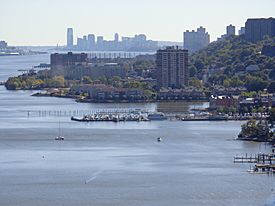
Even with all the new buildings, there have been some challenges. When an old Alcoa plant site was being turned into condos, construction had to stop. The land needed to be cleaned up because of industrial chemicals. In another case, a new building project was stopped for six months to protect workers from lead and arsenic in the soil. Next to this site, there's still a Superfund site, which is a place that needs a lot of environmental cleanup.
Edgewater's Location and Natural Features
Edgewater is a narrow strip of land along the Hudson River. It has about 3.5 miles (5.6 km) of waterfront. The Palisades Cliff rises steeply on its western side. This cliff forms a natural border. Fort Lee and Cliffside Park are located on top of the cliff. Edgewater is next to Fort Lee Historic Park to the north.
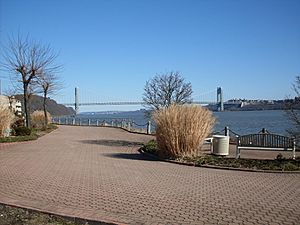
River Road runs through the town, overlooking the Hudson River and the Manhattan skyline. Three roads go up the Palisades Cliff:
- Route 5 goes up to Palisades Avenue.
- Gorge Road and Edgewater Road (also known as Oxen Hill Road) lead up to Cliffside Park.
Edgewater shares borders with Cliffside Park and Fort Lee in Bergen County. It also borders North Bergen in Hudson County. Across the Hudson River, it faces the New York City borough of Manhattan.
Who Lives in Edgewater? Demographics
| Historical population | |||
|---|---|---|---|
| Census | Pop. | %± | |
| 1900 | 1,006 | — | |
| 1910 | 2,655 | 163.9% | |
| 1920 | 3,530 | 33.0% | |
| 1930 | 4,089 | 15.8% | |
| 1940 | 4,028 | −1.5% | |
| 1950 | 3,952 | −1.9% | |
| 1960 | 4,113 | 4.1% | |
| 1970 | 4,987 | 21.2% | |
| 1980 | 4,628 | −7.2% | |
| 1990 | 5,001 | 8.1% | |
| 2000 | 7,677 | 53.5% | |
| 2010 | 11,513 | 50.0% | |
| 2020 | 14,336 | 24.5% | |
| 2023 (est.) | 14,678 | 27.5% | |
| Population sources: 1900–1920 1900–1910 1910–1930 1900–2020 2000 2010 2020 |
|||
In 2011, about 2,500 Japanese-Americans lived in Edgewater and Fort Lee. This is the largest group of Japanese-Americans in New Jersey. More recently, in 2013–2017, about 35.7% of residents were Asian. This included 18.1% Korean, 5.2% Asian Indian, and 4.7% Japanese.
2010 Census Snapshot
The 2010 United States census counted 11,513 people in Edgewater.
- About 53.3% were White.
- About 4.9% were Black or African American.
- About 35.5% were Asian.
- About 11.1% were Hispanic or Latino (of any race).
- Korean Americans made up 19.6% of the population.
The average household had 2.04 people, and the average family had 2.76 people.
- 17.7% of the population was under 18 years old.
- 43.6% were between 25 and 44 years old.
- The median age was 37.2 years.
Edgewater's Economy and Shopping
Edgewater was home to the Lever Brothers research center. Here, a chemist named Vincent Lamberti invented Dove soap, which was the first soap not made with animal fat.
Edgewater has five main shopping areas, all located along the Hudson River side of River Road:
- Town Centre
- Binghamton Shopping Plaza
- Mitsuwa Marketplace
- Edgewater Commons
- City Place
These shopping areas are also next to the River Walk. In 1984, the town didn't even have a supermarket! But by 2017, you could buy groceries at Whole Foods Market, Trader Joe's, Japanese groceries at Mitsuwa Marketplace, and at Acme Markets.
Arts, Culture, and Local Landmarks
Several important buildings in Edgewater are listed on both the National Register of Historic Places and the New Jersey Register of Historic Places. These include:
- Borough Hall: Built in 1904, it received money for restoration in 2009.
- The Binghamton Ferry: This ferryboat was built in 1904–1905. It is the only double-ended steam-powered ferry boat still on the Hudson River. It used to carry passengers from New Jersey to Manhattan until 1967.
- The Edgewater Public Library: This is one of the remaining Carnegie libraries in New Jersey. It was built with $15,000 from the Carnegie Foundation and opened in 1916.
The Eleanor Van Gelder School is also listed on the New Jersey Register of Historic Places.
The River Walk: A Scenic Path
The path along the Hudson River is part of the Hudson River Waterfront Walkway. In 1988, a state law said that a walkway should be built along the Hudson River from Bayonne all the way to the George Washington Bridge. Property owners were supposed to build and maintain it. While many parts are finished, there are still some gaps, especially in Edgewater. The completed sections offer great views of Manhattan while you walk along the river.
Edgewater's Famous Parrots
Edgewater is home to a group of wild monk parakeets, also called Quaker parrots. These small, green parrots are originally from South America. They have lived in Edgewater since at least 1980. In 2008, there were about 200 to 230 of them. You can easily see them in Memorial Park.
These parrots build large nests made of twigs and down that they use all the time. Some nests can be four feet long! No one knows exactly how the birds got to Edgewater. One popular story says they escaped from a damaged crate at John F. Kennedy Airport in the 1960s. Another idea is that they were pets who escaped.
Sometimes, the birds build nests on utility poles near electrical transformers. The power company, PSE&G, has removed these nests because they can cause fires. This has led to disagreements with people who want to protect the parrots. In 2008, PSE&G agreed not to remove nests during the breeding season.
Parks and Fun in Edgewater
Veterans' Field is a 22-acre (8.9 ha) park that offers many fun activities for residents. It has a Community Center and an American Legion Post. Veterans' Field is located on River Road (County Route 505) in northern Edgewater, right along the Hudson River.
The park has:
- Indoor and outdoor basketball courts
- Three softball fields
- A 1/3-mile (0.54 km) track for runners, walkers, and skaters
- Tennis courts
- A Little League field
- A playground
It's also home to a very large American flag that can be seen from Manhattan. A historical plaque about the New Netherland settlement of Vriessendael is at the entrance to the field. Interestingly, the field is much larger now than it was in de Vries's time. In 1922, dirt from the construction of Yankee Stadium in the Bronx was dumped into the Hudson River to create more land for the park. In September 2011, Veterans' Field was closed for a while to clean up contaminated soil that had been brought to the site.
Learning in Edgewater: Schools
The Edgewater Public Schools serve students from pre-kindergarten through sixth grade. In the 2018–19 school year, the district had two schools and about 1,022 students.
- George Washington School: For students in Pre-K through 2nd grade.
- Eleanor Van Gelder School: For students in 3rd through 6th grade.
Because the number of students was growing fast, George Washington School opened in September 2012 with an extra floor to handle more students.
For students in seventh through twelfth grades, Edgewater students attend schools in the Leonia Public Schools district. This is part of a "sending/receiving relationship" between the towns.
- Leonia Middle School: Edgewater students attend for 7th and 8th grades.
- Leonia High School: For students in 9th through 12th grades.
Students from Edgewater and all of Bergen County can also apply to special high school programs. These are offered by the Bergen County Technical Schools, which include the Bergen County Academies in Hackensack and the Bergen Tech campus in Teterboro or Paramus. These programs are very selective.
Holy Rosary Church in Edgewater helps support the Christ the Teacher School. This is a Catholic school for grades K–8 in Fort Lee.
Getting Around Edgewater: Transportation
As of 2010, Edgewater had about 11.19 miles (18.01 km) of roads. Most of these were maintained by the town itself.
- County Route 505 is the main north–south road in Edgewater.
- Route 5 also goes through the town and ends at CR 505.
Major highways like Interstate 95 (including the New Jersey Turnpike and George Washington Bridge), U.S. Routes 1/9, U.S. Route 46, and the Palisades Interstate Parkway are all nearby. You can reach them using CR 505 in Fort Lee.
Buses and Ferries
New Jersey Transit buses offer routes to the Port Authority Bus Terminal in Midtown Manhattan (routes 156, 158, and 159). There's also route 188 to the George Washington Bridge Bus Terminal. Local bus service is available on routes 751 and 755.
You can also take a ferry to the West Midtown Ferry Terminal in Manhattan. NY Waterway offers this service from Edgewater Landing, where Route 5 meets River Road. There's no parking at the ferry terminal, but a shuttle bus run by the borough can take passengers there. In Manhattan, you can transfer for free to a network of buses run by NY Waterways.
In the past, several ferries operated in Edgewater. The last ferry in the 20th century crossed the river in 1950. Edgewater was also where many electric trolley lines in New Jersey ended. The trolley terminal was across River Road from the old ferry terminal. It even offered rides to the top of the Palisades Cliff. The trolley service stopped in 1938.
In July 2012, bike lanes were added to River Road as part of a road repaving project.
Sister Cities
On November 16, 2020, Edgewater officially became a sister city with Loma De Cabrera, in the Dominican Republic.
Famous People from Edgewater
Many interesting people have lived in or are connected to Edgewater, including:
- Amerie (born 1978), R&B singer
- Natalie Anderson (born 1986), TV personality and winner of Survivor: San Juan del Sur
- Coco Austin (born 1979), model
- Tyson Beckford (born 1970), model
- Cardi B (born 1992), rapper
- Maksim Chmerkovskiy (born 1980), professional dancer from Dancing with the Stars
- Liz Claman (born 1963), Fox Business Network anchor
- Barbara Corcoran (born 1949), real estate investor from Shark Tank
- Harris Faulkner (born 1965), newscaster for Fox News Channel
- Ice-T (born 1958), rapper and actor
- JoJo (born 1990), singer
- Q-Tip (born 1970), rapper
- Geraldo Rivera (born 1943), newsman
- John Sterling (born 1948), radio announcer for the New York Yankees
- Osi Umenyiora (born 1981), football player for the New York Giants
- Chien-Ming Wang (born 1980), baseball pitcher for the New York Yankees
- Norman Joseph Woodland (1921–2012), inventor of the barcode
See also
 In Spanish: Edgewater (Nueva Jersey) para niños
In Spanish: Edgewater (Nueva Jersey) para niños


